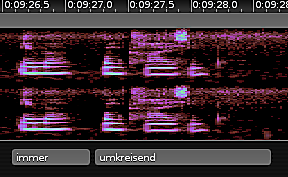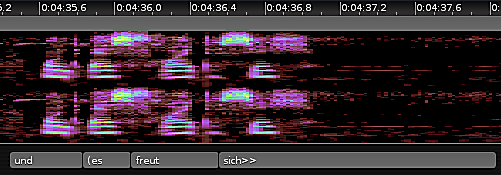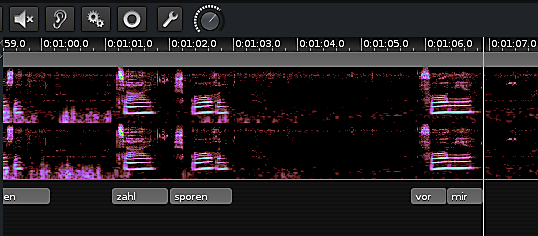I have worked multiple times with voice recordings, both of my own voice, and of other speakers' voices. I am interested in what makes the sound of the voice transcend the plain discrete level of the underlying text.
{function: contextual}
Defining a repertoire of movements. One might be where two words are phonetically separated by follow each other closely, allowing for oscillation:
immer umkreisend immer umkreisend immer umkreisend immer…
{kind: caption, group: immer}
12-Aug; I am defining now 'diacritics' that give information about possible beginnings within a phrase - ( -, and as the birds and wind produce a background layer, indicators for fade-in (< for 500ms in, > for 500ms out, >> for 1000ms out, etc.). This will also aid the pairwise similarity matching, as we will cut away these fades during this process. In the installation, it could mean that if two adjacent channels are "polyphonic", they can overlap during these periods.
{kind: caption, group: diacritics, date: 170812}
The voice recording uses an "obsolete" version of the text. As the most recent version will be used for the Eye, this opens up a very interesting case, where words will have to be mutated, inserted, removed as sound is emitted from the Eye.
… saugt sich an (mein bewusstsein) liebt mich …
{kind: note, function: contextual}
Perhaps there will be words and sequences escaping from the Eye. What we did in St. Lambrecht thus was to record the then current state of the text at quite slow tempo, making it possible to isolate words or sequences of words.
The next step is to annotate the recordings to be able to algorithmically access these sections.
{kind: note, function: contextual}
GermaNet is a German language database correspondence to WordNet, a well known English lexical database, that allows searching for synonyms and proximities between words. Perhaps I will use this database to generate topologies within Gertrude's text. (GermaNet, although a publicly funded project, has some odd, to say the least, license terms, and it is not publicly accessible).
{kind: note, function: contextual, keywords: [Germanet, WordNet, lexical, database]}



